PREVIOUS ENTRY | NEXT ENTRY
PRINT THIS PAGE OUT USING A COLOR PRINTER, AND READ IT AT LEAST TWICE BEFORE LEAVING FOR YOUR TRIP. CHECK OFF ALL THE ITEMS LISTED TO MAKE SURE YOU HAVE EVERYTHING YOU NEED!
Editor's Note: This email is the latest crew's equipment list and FAQ for sailing from Puesto Del Sol, Nicaragua to San Francisco, California, with at least one stop in San Diego along the way. It is an updated version of the original trip list. It is really intended for crew members, doesn't have all that much humor to it, and is more a checklist than a fun read.
Our suggestion, if you aren't planning on sailing along on this trip, is to skip on to something more interesting (we recommend using the Blog Archive Index on the right and clicking on "Eggerator", "or "Canal Transit", or "Aussie Nature Show") and have fun. If, however, you are planning to sail with us, then the following is required reading. It should contain all the information you need to know about what to expect, what to bring, and how to behave. You can also read the previous posts for other details about how prior trips went, and the issues we encountered.
Hey All,
If you're getting this it is because I believe you have expressed real interest in being on board the catamaran "Triton" during the transit from its current mooring in Marina Puesta Del Sol , in Nicaragua to fabulous, sunny, windy San Francisco Bay, in California. If you've changed your mind or don't wish to get this info, please let me know at "RobbTriton"atsign"gmail"dot"com" or at "TritonCat"atsign"gmail"dot"com"
This is a long email. It contains as much info and insight as I can think of. I'm sure I've left something out, if you have any questions don't hesitate to ask.
Agenda
First things first: Current plans are that I will arrive at Marina Puesto Del Sol in El Estero de Aserradores, Nicaragua between the 15th and the 17th of October and begin readying the boat for the passage. Since she was in ready condition when I last left her, and have left people looking after her daily, this shouldn't involve too much work - the bulk of which consists of airing her out, scraping her bottom clean, putting the dinghy back in the water and making sure everything still works. You are welcome to arrive there anytime during this period. I expect to leave the Marina on or about the 1st of November, weather permitting.
The trip up is roughly 3000nm done in three separate legs (somewhat less, but lets be conservative). The prevailing winds will be against us at times, so assume at the very best 200nm per day motoring under typical conditions. Most likely we will break this part up into at least three separate legs, stopping in Cabo San Lucas in Mexico after about ten days, then San Diego, then SF, with holders in between for weather, provisioning, recuperation, etc.. This is no easy run down wind, and is considered one of the tougher trips you can make on this half of the globe. If you've been reading the blog and got the impression that we'd spend every day lazing about under sunny skies and fair winds, you might be disappointed.
Going "up hill" (as a northerly route along the West Coast is called) can be pretty difficult. The wind, waves and current are predominantly on the nose, which means either hard sailing to weather, or motoring against it. We will be hiring a weather planner (an expert meteorologist that studies the wind, wave and current patterns and suggests the most favorable route) but most likely we will be motoring hard along a significant amount of the time. We will try to take advantage of any wind or currents we can, so our path might be anywhere between close to shore or sixty miles out.
That puts us in the Cabo around the 10th or 12th, San Diego harbor at between the 25th and the 30th of November, San Francisco sometime early December. We do not make any commitments about being anywhere at that time, nor can we honor any schedule or any plane trips that you can't revise on the spot. (see note below about sailing on a schedule) We will most likely be within this time frame but could be off, there are no guarantees. We might also need to stop in Mag bay or Turtle bay in Mexico for additional supplies and fuel, if need be. Anyone running out of time could jump off (or on) at any of these points as well.
The plane flight down to Nicaragua should cost about $600.00. We just did a price check on Expedia and Sidestep and got similar results. AnnMarie prefers to use Expedia, but use whatever service you believe gets you the best deal. Buying an open ended ticket should figure into this equation. If you would like to meet us somewhere else along the route, we will be happy to try to schedule this in route, and AnnMarie can help coordinate everything, but you'll need to be flexible about when you arrive at some way point and understand that our best intentions around picking you up are always at Mother Nature's whims. In the poker game of life, one hurricane beats a full hotel reservation.
This is not a pleasure cruise. We will not stop until our next way point unless some critical provision like water or fuel runs low, or there is some major mechanical failure or weather condition that necessitates heading for port. In that case we will head towards the safest harbor within sailing distance.
If at any time you decide that the trip has delayed more than your schedule can permit, then whenever we next make land, you will be able to leave the boat and make your own arrangements for flying back home. (see note below about documentation), but be warned that we may not be able to accommodate anyone's schedule. It's an adventure, not a pleasure cruise.
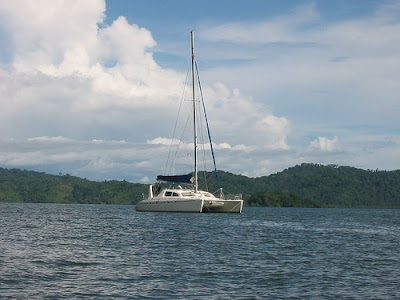
Vessel
The vessel is a 45' cruising catamaran, equipped for blue water sailing. There are lots of photos of her throughout the blog, scan around for various angles of the berths, the salon & galley, the engine compartments, etc. One thing you should understand, this is a very large boat. If you had any concerns about being "squished in" with each other, you are probably thinking about a monohull.
 Every cabin has its own private bath/shower, and there is plenty of room on the trampolines, decks, cockpit and sugar scoops (the steps leading down to the water at the aft end of the boat) to hang out on. No one has ever reported feeling claustrophobic on this boat.
Every cabin has its own private bath/shower, and there is plenty of room on the trampolines, decks, cockpit and sugar scoops (the steps leading down to the water at the aft end of the boat) to hang out on. No one has ever reported feeling claustrophobic on this boat.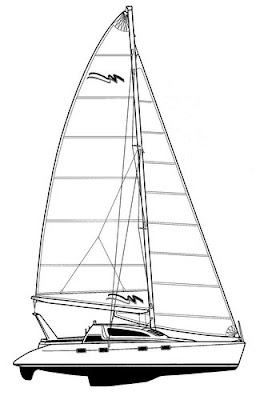
It has four separate state rooms, each with a queen size bunk and a private bath

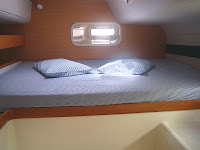
and a galley, a salon, galley and navigation station enclosed in the bridge deck which spans the amas (the name for each hull of a catamaran is an "ama") large enough to easily handle eight to ten people comfortably, as well as a protected steering station and cockpit with seating for twelve.
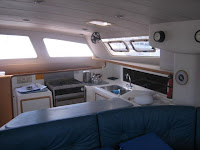 The forward section includes a large trampoline for sunbathing, as well as an aft deck and "sugar scoops" (steps leading down to the water from the transom) for easy loading and access. The cabins are spacious with plenty of storage, but due to the design, head room above the bed is less than 36" (see attached photos), but otherwise it is very comfortable, especially
The forward section includes a large trampoline for sunbathing, as well as an aft deck and "sugar scoops" (steps leading down to the water from the transom) for easy loading and access. The cabins are spacious with plenty of storage, but due to the design, head room above the bed is less than 36" (see attached photos), but otherwise it is very comfortable, especially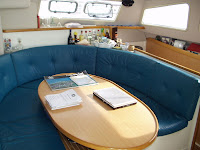 if you've ever been on a comparably sized monohull. The large dining table in the salon also folds down into another sleeping area if need be.
if you've ever been on a comparably sized monohull. The large dining table in the salon also folds down into another sleeping area if need be.The starboard aft (back, right) stateroom is mine, and I will not share that with anyone (owner's/captain's rights), which leave three staterooms for whomever are coming. Most likely everyone will have their own room, if this becomes an issue we'll discuss it later and work something out. Some folks may need to double up if we have more than five or six folks on board - but this hasn't ever been a problem before. If you show up with a spouse, significant other or temporary squeeze, you get first dibs on a stateroom, as long as both of you remain on board, otherwise the rooms are available as first come, first serve.
 If all three are filled with singles, and someone else comes along, they get doubled up with the last one on board. Couples always get priority on staterooms.
If all three are filled with singles, and someone else comes along, they get doubled up with the last one on board. Couples always get priority on staterooms.Keep in mind, these are queen size beds, easily shared between non-roommates. If you find yourself having to bunk in with someone you don't know, then rest assured we will set up the watch schedule so that neither of you are sleeping in the bunk at the same time. There is also a large salon table that can convert to a bed if need be, but it is in the center of the bridge deck and lacks privacy or quiet.
In reality, this has never been an issue for anyone before. Try not to be the first.
Rewards and Responsibilities
There is no fee or cost in doing so, you are traveling as our friends, but you are responsible for making your own travel there and back and living arrangements when not on board.
Each member on board is expected to perform some minimum effort towards the boat (see details below), as well as help in transporting the necessary gear from California to wherever the boat is, when needed. We are not responsible for any expense you might acquire while traveling with us, including your medical costs, your insurance, your travel expenses or your cost of living expenses while traveling with us. We do not have insurance that will cover you in the event of an injury or disaster. You must arrange for this coverage yourself. You are not being hired on as paid or professional crew, and nothing should be construed as remuneration or reimbursement. You will not be paid for anything. This is not a "delivery" and we are not sailing to any schedule.
Luggage and Gear
As "crew" you may be expected to bring one or two suitcases (along with your carry own bags) which I will supply.
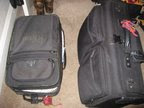 They will already be full of various bits of sailing gear, so don't count on being able to put anything in them. It isn't clear what I'll be able to ship versus what we'll need to bring down by plane, so right now assume you'll each be carrying two of them, that they will meet the airline weight/size guidelines, and that without them we will be missing important supplies. Don't lose them or it could affect the trip.
They will already be full of various bits of sailing gear, so don't count on being able to put anything in them. It isn't clear what I'll be able to ship versus what we'll need to bring down by plane, so right now assume you'll each be carrying two of them, that they will meet the airline weight/size guidelines, and that without them we will be missing important supplies. Don't lose them or it could affect the trip.Additionally, you should be able to carry on a "purse" or "briefcase" or "laptop" and one traditional carry on bag. I've created a list of what I believe are appropriate and necessary personal items needed for this trip, all of which should go in your carry on bag. Consider this as your own shopping list if you don't already have a lot of sailing gear. If you have any questions about any of this please ask me via email, and cc everyone else on the list so we increase the knowledge sharing aspect of it as well.
You should expect that your carry on bag will contain the following items:
All items marked with an asterisk are mandatory - you must have these to go sailing with me!
All items marked with a question mark are optional - they are nice but not absolutely necessary.
All items marked with a plus sign are recommended you wear on the plane, to minimize carry on space issues.
NOTE: Some of this gear is expensive. If you don't already have it, and aren't likely to do a lot of sailing, then ask if we have spares to loan you. Mostly likely we will. Things like PFDs, harnesses, tethers and Foulies can be arranged, but only with sufficient notice. We most likely can cover you, but if this is the only reason stopping you, don't worry about it, we'll figure something out.
Carry On:
* Scopolamine transderm patches,
enough for every day you expect to be at sea, plus one extra three day supply. It is considered a polite gesture to leave any remaining unused patches behind after the trip for other crew that might need them.
* 2 Towels, at least one large enough to use as a beach towel.
*+ 1 Foul Weather Jacket
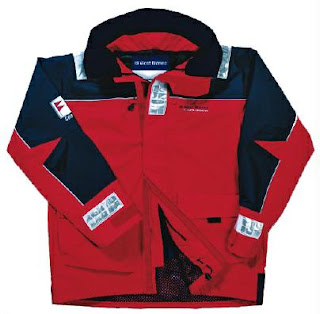
my suggestion is the West Marine Offshore, which I think is an excellent product.
*+ Foul Weather Bibs
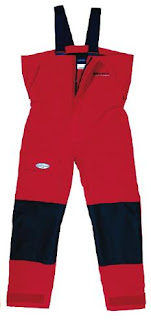 pretty much what ever is comfortable, but make sure they are easy to get on over warm fleece.
pretty much what ever is comfortable, but make sure they are easy to get on over warm fleece.*+ 1 Deck sneakers appropriate for weather use: Fathom FisherMen Laceups or Sperry Topsiders or the classic rubber deck boots or something equivalent. For cold weather you want to stay dry, for warm weather you will want breathability. If we are sailing in both conditions you may want a pair of each.
*+ 2 pair of polarized, UV blocking sunglasses & croakies (straps). If possible, get 1 with a sunblock nose guard and 1 pair of backup sunglasses, all with their own hard cases. Trust me, glasses get lost, sat on or broken. You'll want at least this many each with their own clasps, and something to protect them.
1 pair of sailing gloves. Okay, this isn't mandatory, and a bit on the religious side. I don't use them, but lots of folks hate handling lines, especially in cold weather without them. I've found that WholeFoods has gardening gloves that work great as well. If you're anticipating temperatures below seventy degrees, you probably want something.
* Type 3 auto inflating PFD / Harness with D Rings.
 Note: previously, you were not allowed to bring the inflater cartridge on the plane, even in your checked luggage. This has changed recently, as too many folks kept showing up at sailing sites without working PFD's. Apparently, the Coast Guard sued the TSA and forced them to change their ridiculous rules. You might still get hassled about it, and they might try to confiscate the cartridges, but I strongly recommend you pack them anyway, with both the primary cartridge installed and the secondary cartridge in the backup sleeve of the PFD, and put this in your checked luggage. Most times they don't notice or will let it slide anyway. Before you come down (at least two weeks), let me know exactly what type cartridge (make, model, size, etc.) you have so that I can check the local chandlery to see if they stock it should you need to additional cartridges or auto inflater triggers. Mostly likely we won't be able to buy anything in Nicaragua, we'll probably be able to find something once we hit Mexico. Make sure whichever PFD you get has D-Rings already built into the harness (like the one on the right- as opposed to the one on the left) otherwise you will need a separate, additional harness.
Note: previously, you were not allowed to bring the inflater cartridge on the plane, even in your checked luggage. This has changed recently, as too many folks kept showing up at sailing sites without working PFD's. Apparently, the Coast Guard sued the TSA and forced them to change their ridiculous rules. You might still get hassled about it, and they might try to confiscate the cartridges, but I strongly recommend you pack them anyway, with both the primary cartridge installed and the secondary cartridge in the backup sleeve of the PFD, and put this in your checked luggage. Most times they don't notice or will let it slide anyway. Before you come down (at least two weeks), let me know exactly what type cartridge (make, model, size, etc.) you have so that I can check the local chandlery to see if they stock it should you need to additional cartridges or auto inflater triggers. Mostly likely we won't be able to buy anything in Nicaragua, we'll probably be able to find something once we hit Mexico. Make sure whichever PFD you get has D-Rings already built into the harness (like the one on the right- as opposed to the one on the left) otherwise you will need a separate, additional harness.* 6' (stretch) tether, preferably with a 3' (static) secondary tether.
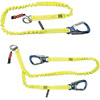 I would recommend the WestMarine tether, or Witchard Model# 7006. This device is used is used to attach you to the jack lines which are lines that run along the length of the boat, and across the width of the boat at the mast. One end clips to the D-Rings of your harness, and the other end(s) clip into the jack lines. The reason for the second shorter leash is if you need to switch from a bow to stern jackline to one of a line running abeam.
I would recommend the WestMarine tether, or Witchard Model# 7006. This device is used is used to attach you to the jack lines which are lines that run along the length of the boat, and across the width of the boat at the mast. One end clips to the D-Rings of your harness, and the other end(s) clip into the jack lines. The reason for the second shorter leash is if you need to switch from a bow to stern jackline to one of a line running abeam.* 1 Personal Strobe light appropriate for your PFD with new battery.


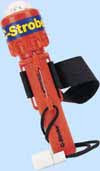 Okay, there are lots and lots of different types of strobes here. The best solution is to get the type that is matched to your PFD, but there are so many possible alternatives that also work that I won't even try to pick a single solution. My suggestion would be one that operates automatically when your PFD inflates, in case you aren't conscious when you fall overboard. If if you are, remembering to do this is not what you want to be concentrating on when you are dealing with a situation like this. Make sure you also have a backup battery as well. Don't skimp on this, your life may depend on it.
Okay, there are lots and lots of different types of strobes here. The best solution is to get the type that is matched to your PFD, but there are so many possible alternatives that also work that I won't even try to pick a single solution. My suggestion would be one that operates automatically when your PFD inflates, in case you aren't conscious when you fall overboard. If if you are, remembering to do this is not what you want to be concentrating on when you are dealing with a situation like this. Make sure you also have a backup battery as well. Don't skimp on this, your life may depend on it.1 or 2 swim trunks or jammers or surfer pants. You will most likely wear these every day for the entire trip. Take a look at our pictures and count the number of different outfits we wore over three months. You don't need a lot!
1 or 2 long sleeved (UV protective) cotton or synthetic shirts that cover your shoulders. I can't stress this enough - bring long sleeve, light weight, cotton clothes. You will need protection from the sun, and sun block will not always be the right answer.
*+ 1 lightweight dress shirt. Something nice, that you could wear out to a reasonable restaurant.
*+ 1 lightweight dress pants (or skirt/dress). Same as above. This outfit will be your "show up at the port captain's office outfit".
1 pair comfortable dock/deck shoes: crocks, topsiders, or some "deck friendly" nonabrasive, non marking, nonskid shoe. To be worn with the above.
? 1 pair water socks: aqua socks, skin diving booties, or some such. This turns out to be something quite useful if you are going to go exploring, or swimming with fins that might be too big, or going from dinghy to dock, etc. Something with a non-skid bottom is best, or pair them up with waterproof (plastic) sandals.
*+ 1 pair wool (or synthetic equivalent) socks. Your feet will get cold - this can really improve you attitude if you have to spend time on watch on a breezy night.
? 1 pair thin cotton socks. If you get a blister, or need to walk around town, or just want something between your feet and the wool socks, this will be really nice to have.
*+ 1 very large straw or cloth sun hat with straps or built in flotation. This turns out to be something you really ought to bring two, or even three of. I have a half dozen hats on board, and am always on the lookout for more.
? 1 baseball type cap with brim and clip strap.
? 1 fleece lined cap that fits under foully jacket hood. This is nice for cold weather, or mild weather with high winds. I like it just to protect my ears from the wind.
1 polypro long johns and top. You may not need them, but if you do, you really need them.
1 fleece pullover or jacket. Same as above.
? 1 fleece pants (you won't need them unless it gets cold during a storm, then you'll sell your soul for them).
* 1 headlamp. (preferably with both red and white led options - if you can afford to bring two, do so).
? 2 lightweight sarongs. Okay, this turns out to be the thing most guys don't bring, then end up wishing they had. They are easy to pack, easy to wear, and comfortable as hell. Trust me, you'll love them.
whatever personal hygiene products you require.
Also, limit what ever else you think you absolutely have to bring (especially clothes) to a minimum. Very often folks drag down a lot of stuff that never gets used and is just dragged back home. I doubt you'll feel like reading the first few days, so books, especially big, heavy work related books or paperwork might turn out to be a waste of effort, whereas cameras, videocameras and such tend to be very useful. Make sure whatever electronic equipment you bring has its own (very safe) waterproof containers.
Also, there is a laptop on board. It is absolutely not for your use. If you want to use a laptop for any reason whatsoever, you will need to bring your own. Do not ask to use the ship's laptop. It is strictly for navigation and communication purposes only. Don't even think about touching it without the captain's direct permission and oversight. This is not a matter to treat lightly or dismiss. Our lives depend upon certain important pieces of equipment, such at the engines, compass, depth sounder, radios, chart plotters, and other various electronic components. The ships computer is very much a part of this system, regardless of how much it looks just like your laptop at home. Ignoring this order is tantamount to mutiny. You will be asked to leave the ship if you violate this boundary. This is not a joke.
On the lighter side...we do have a bunch of masks, snorkels and flippers, you probably don't need anything for skin diving, unless you require a prescription mask or definitely want to have the right size flippers. I would recommend you get a nylon "dive skin", just something that covers your body completely when you are swimming, in case you bump into the occasional jelly fish.
NOTE: if you have prescription lens, bring an appropriate dive mask for them, or get those lens that glue into a regular mask. If you have unusually large or small feet, bring your own flippers.
Travel Arrangements
You will need to fly into Managua, Nicaragau, and then take a bus or taxi (a two hour trip) to Puesto Del Sol. Check with us as you may be able to share a ride with others going down there.
Nicaragua is a Spanish speaking country, so bring your translation book. Managua is a pretty dirty, grimy city, without much to offer. Crime is pretty high, and spending time there isn't worth the effort. Puesto Del Sol is an island of luxury inside the jungle, but everything else around there is very, very poor.
The boat is currently on a mooring at Puesto Del Sol. Tell them you are here to meet Robb Kane on "Triton".
Marina Puesta del Sol Resort - Aserradores
Attention: Maria Laura Cano
Marina Puesta del Sol
Aserradores, El Viejo, Chinandega,Nicaragua
Pacific Coast of Nicaragua 9 kilometers north of Corinto
Entrance Buoy Coordinates:
Lat. 12° 36.55’ North and Long. 087°22.41’ West
Tel: (011 from U.S.) 505-883-0781, 505-880-0019, 505-880-0013
email: mpuestadelsol@yahoo.com
VHF Channel 16
Marina Puesta del Sol – U.S.A.
Marina Puesta del Sol Inc.
2072-B Walsh Avenue
Santa Clara, CA 95050
Attention: Marc Membreño
Telephone: 408-588-0017 Fax: 408-588-1550
email: info@marinaps.com
Documentation
We live in a free country. You can move about without asking any one's opinion or permission. All that is about to change. In order to go sailing you will need a passport, a health certificate, a driver's license or photo id, at lease one valid credit card and/or cash enough to get you back home.
If you don't have a passport, get on it NOW. They can take months to obtain. You need a passport that is valid for at least six more months. Trust me that you do not want to have to replace one overseas. Nothing will suck more than flying to another country, missing the boat ride, and spending the next few weeks trying to get a new one before you can get back in the country.
The health certificate (also sometimes called your "yellow" card because it is traditionally printed on hard stock, yellow paper) is something you obtain from your doctor. It includes certifications of each of the various inoculations you've had since childhood (measles, pox, etc.) as well as any other booster shots (tetanus, hep A/B, etc.). BTW, if you haven't had one lately, get another tetanus shot. They are good for five years. Also, ask you doctor about getting vaccinated against Hepatitis A & B. The entire process takes about six months, but it is worth doing on general principles and lasts for decades.
You probably won't need a yellow card for this trip, we aren't going to be stopping anywhere that might require it, but you should probably start creating one, and update your boosters for tenus, HEP A/B, whatever, anyway.
NOTE: When you come aboard, you will surrender your passport to me. By law I'm responsible (as captain of the vessel) for having it in my possession. If you decide to leave the ship ahead of time, we must both go to the Harbor Master or Port Captain and change the boat's visa documentation. You will need to provide proof of transport (usually a plane ticket) before you name can be removed from the boat manifest. This is no small matter. Ships can be prevented from leaving the country unless everyone is accounted for or on board. Entering another country without everyone on the manifest can result in fines, impounding the vessel or detainment. This isn't something I wish to treat lightly, please understand that the consequences of not doing everything according to the letter of the law can be serious. Your cooperation is mandatory on this issue.
Safety Equipment
As to other safety equipment on board, besides the standard equipment one would
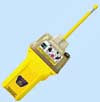 expect to find such as flares,
expect to find such as flares, 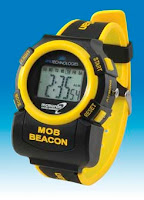 dye, smoke, flotation, life vests, etc., the boat will be equipped with a 406MHz EPIRB, several VHF radios as well as a HAM & SSB radio, several hand held GPS, at least two chart plotters, Radar, Sonar, Sea Anchor, Drogues and each crew member will have a MOB wristwatch which can automatically engage on immersion. There is also a matching Radio Beacon Direction Finding device for tracking anyone who does go overboard wearing one of these watches.
dye, smoke, flotation, life vests, etc., the boat will be equipped with a 406MHz EPIRB, several VHF radios as well as a HAM & SSB radio, several hand held GPS, at least two chart plotters, Radar, Sonar, Sea Anchor, Drogues and each crew member will have a MOB wristwatch which can automatically engage on immersion. There is also a matching Radio Beacon Direction Finding device for tracking anyone who does go overboard wearing one of these watches.YOU WILL BE REQUIRED TO WEAR A MOB (man over board) WATCH WHENEVER YOU ARE OUTSIDE THE SALON FROM DUSK TO DAWN, OR IN INCLEMENT WEATHER, OR AT THE CAPTAIN'S DISCRETION. YOU WILL NOT COMPLAIN ABOUT IT. YOU WILL NOT CLAIM IT DOESN'T WORK. YOU WILL NOT STUFF IT BENEATH YOUR MATTRESS THEN CLAIM YOU CAN'T FIND IT. YOU WILL NOT BITCH ABOUT IT. YOU WILL NOT BE PASSIVE/AGGRESSIVE ABOUT IT EITHER.

There is also a Radio Direction Finder (RDF) that constantly monitors for any emergency beacon signal on this frequency, and can be used to pinpoint locate the source. So, if you fall overboard, we can find you, even at night, even in a storm - providing you are wearing your watch, and we've all practiced using this device. Expect to conduct at least one practice session before setting sail, which means spending at least four hours not having fun, but potentially saving your life should you fall overboard in a storm.
We also have the standard medical bag, which will cover the basics emergencies such as lacerations, burns and the like. If you have any special needs (allergic reactions, daily meds, etc.) or if you desire to bring any additional safety equipment please let me know now so that we can include this in our preparations.
Communications
The boat is equipped with a standard VHF radio for ship to ship and ship to shore (within twenty miles) communication. It also has (barring technical difficulties) a HAM radio for long distance communication, an operational Single Side Band (SSB) radio capable of making overseas calls, sending email and retrieving weather faxes, as well as an emergency Iridium satellite phone capable of reaching almost anywhere in the world under almost any weather condition. Using the SSB ship to shore phone is somewhat pricey, lacks privacy and requires good atmospheric conditions. If you need to make a call, we can try to put it through, but it may not always be possible.
SSB Email is less problematic, tends to be more reliable, but is slow. It can take significantly longer to send and retrieve emails, but it is relatively inexpensive to do so. Do not rely on this as a means of communication, but if it is necessary to send an occasional post, we should have the ability to do so while at sea.
The satellite phone is a measure of last resort. It is easy, convenient and reliable, but very, very expensive. If it is an emergency then this is what we will most likely use if the SSB operation isn't successful. Please understand that these are not free services and we expect that you will reimburse us for any costs we incur in delivering your messages. If you believe you absolutely need to make phone calls, then we suggest you purchase a digital prepaid card for the phone. These can be obtained at chandler's such as West Marine, or through various electronic device dealerships, for amounts between $75 and $150 that will purchase prepaid calling time.
Sea Sickness
First off, everyone gets sea sick eventually. Some have it frequently, others rarely, no one is immune. Mark Twain, during his time aboard ships, discovered an amazing cure for sea sickness, with an effectiveness approaching 100%. He found that placing the patient's head directly at the base of a California Oak tree not less than fifty feet high, with the patient's feet extending horizontally outward and due north, relieved symptoms almost immediately. Alas, we do not have room on board for such a tree and are limited to other, more pedestrian cures.
First off, don't worry about it too much, as it affects almost everyone for the first day or two of a passage, and then subsides naturally. For me, I'm normally very queasy the first two days at sea. If I can stay warm, dry, well hydrated and get plenty of sleep, it goes away and from then on in I'm fine. As a crew member I almost always take anti-nausea meds for the first few days - usually Sturgeron (it isn't available in the states, but is an over the counter drug almost everywhere else) usually starting about twelve hours before we set sail. If sea sickness symptoms progress to vomiting I'll switch to the transderm patch, which works whether I'm yowling or not. It tends to knock you out for a few hours, but after that you're usually great and can function both above and below decks.
I'll have plenty of Sturgeron on hand, but I insist that everyone bring their own Scopolamine patches. They aren't cheap, and they require a doctor's script, so get this done soon (now) and don't worry about it. Dashing around at the last minute for this is a huge hassle.
NOTE: You want to put on the patch AT LEAST twelve hours before sailing. Waiting until you start to feel bad means you'll be sick for twelve hours until the meds have a chance to kick in. You've been warned.
Also, OTC items like Dramamine and Bomine, in my unlimited yet anecdotal experience, don't work. Use them if you must, but don't come aboard without a few days worth of transderm patches as well or you'll be sent home. No joke.
NOTE: I usually don't take medication when I'm the captain, because I don't want anything to affect my judgment or tire me out. If I get really slammed, then I'll use a transderm patch. Don't compare yourself to my habits or anyone else's. If you're at all worried, wear a patch. They work amazingly well.
NOTE: There are lots of things that contribute to sea sickness. Staying away from alcohol, drugs, greasy foods, dank air and enclosed areas helps tremendously. Getting lots of rest, plenty of fluid, vitamin C & B complex, staying above decks, looking out at the horizon and manning the helm all seem to help as well. There are also some claims that ginger helps: we will have various foodstuffs of this on board in the form of raw ginger, candied ginger, ginger beer, and chocolate covered crystallized ginger.
Bring whatever other magic potions or remedies you believe will work for you. Also, sea sickness has a very real psychological component. If you firmly believe something will work, it may just. If you stress or worry about it, you will probably make it worse.
Safety At Sea
Okay, here is the part where reality sets in. This is a dangerous undertaking. Why? Well, the ocean doesn't care about you and will kill you the first chance you give it. Worse still, I, as captain, am morally, if not legally, responsible for your life. To that end, I will not take any chance with your safety, or the other crew members, myself or my vessel. This means that we will always err on the conservative side of things.
In the past, hardy sailing folks didn't use lifelines, netting, harnesses, PFDs, tethers, or any other form of safety device. And they usually got away with it, until they died. This mindset remains prevalent in many sailing communities today, much the way that seat belts or air bags or electronically controlled brakes are still poopoohed by some ignorant drivers.
As you read this, the current thinking about being "tied in" is changing in light of the recent and numerous MOBs (Man Over Board), accidents and drownings that have occurred. Several folks have been caught unawares and washed overboard by rogue waves, even during perfectly good weather! These days, most prudent sailors are realizing that even in the best of conditions, it is best to be tied to the boat. The "old salts" among us may claim that this is overly precautious (this was my attitude as recently as last year) but since I can't afford to risk your life (even if you are willing to) I've revised my rules governing operations above decks. That said, a few explanations about procedures:
1) Anyone outside of the boat, even in the cockpit, during non-daylight hours or in anything but absolutely flat weather, regardless of how little time is intended to be spent or the trivialness of the errand, MUST wear a PFD and harness at all times.
2) The boat will be equipped with jack lines. These are heavy lines that run fore and aft along the inside of the decks, as well as two that run athwart ships just forward and aft of the cockpit, and a crossing line at the mast. Whenever you are standing outside the cockpit coamings, for any reason, at any time, you MUST be connected to these jack lines with a tether and harness.
3) During even the slightest of inclement weather or from any time before dusk until after sunrise, you must attach yourself to a jack line even within the cockpit. Even if you don't intend to go out on deck. No exceptions.
4) No one is to exit the cockpit (cross the coamings) or stand on the aft deck or sugar scoops, for any reason, without someone else in the cockpit and tied in.
Safety Drills
Sorry guys, but I'm just not a "Safety Third" kind of guy, no matter how sexy that is at Burning Man. In fact, I'm well beyond anal retentive (perhaps even epiglottis retentive) about this kind of stuff, so expect to practice what to do in emergencies, and talk a lot about how we will handle certain conditions. Odds are very, very good that everything we discuss or practice will never happen. If it does, then you will know what to do and have done it in simulation at least once.
We will practice MOB drills, including the use of the safety sling and the radio beacon direction finder. We will also practice setting and retrieving the sea parachute and the drogues. Every crew member will also know how to raise and lower the sails, as well as how to operate the anchor windlass, engines, and sail lines. We will practice all of these skills for a full day, including tacks and jibes (sailing maneuvers) before we depart.
I would also like to get the crew together before we leave for a practice round with the MOB RFD. If someone goes overboard at night, this is going to be the single best device for finding them. Understanding how to use it before we need to is paramount!
Insurance
Believe it or not, there is very cheap insurance available through DAN (Diver's Alert Network) that covers you for any accident involving scuba diving, or while on your way to or from the dive site, or if you happen to be injured while doing so. I believe there is also a provision about "vacation insurance" there as well. Since we ultimately want to go diving at some point in this trip, it probably makes sense for you to look into this.
If nothing else, I recommend you speak with your insurance broker or travel agent about obtaining some form of "catastrophic" insurance that would cover you for things like emergency room visits, helicopter rides, ambulance, etc. while in a foreign country. For the amount of money you'll spend, it is well worth the investment.
Sailing Schedules
Sailing is an odd sort of endeavor. On the whole, it is a relatively safe way of traveling, providing one is willing to pay attention to the weather, the condition of the vessel and the ability of the crew. On the other hand, it is one of the most dangerous things you can do if you are willing to disregard climate, ship and shipmates. If you ask around, you'll find that the conventional wisdom regarding passage making is "NEVER, EVER SAIL ON A SCHEDULE!"
This means that if there isn't a perfect weather window, and/or there is anything wrong with the boat, and/or there is some problem that could compromise the abilities of the crew, then we don't sail. Even if this means not getting where you need to be by some specific time. Even if it means you might miss your flight. Even if you can't refund your tickets.
To this end, I must warn you that I will not accept any pressure to leave before everything is reasonably ship shape, the crew is rested, and the weather looks favorable. Now, no one can predict weather perfectly, but modern equipment and expertise is pretty good about alerting you to rough conditions, especially severe gales, storms and hurricanes. We will not sail in these if at all possible, and will delay or detour as far as is necessary to avoid them, regardless of what this does to your plans.
If you have any questions about why I'm so adamant about this particular issue, I suggest you research the last ten sailing disasters that have occurred recently. Count how many of them were (either directly or indirectly) because the crew decided they needed to make a schedule. I believe you'll find that more than half of all sailing accidents include this as a causal factor. By simply following this simple, safe and obvious guideline, we can reduce the chances of having a problem out at sea tremendously.
So, in case this isn't clear, I'll repeat it. We do not sail on anyone's schedule.
Taking Orders, otherwise know as The Captain is an Asshole (or what happens when things go wrong)
Yep, you heard it here first, the captain is an asshole. Partly it's because he grew up in New Jersey, in a bad family, but mostly because its his job is to make sure that everything is done right, that the crew is safe and the boat doesn't sink. In other words, to be as much of a pain in the ass as is necessary to make sure everything is okay - but no more than that!
Look, lets be honest. No one wants to be bossed around. And, truth be told, I don't want to be anything but kind and encouraging, and certainly not your mother. Besides, you guys are my friends, and I want to keep it that way. But I also need you to understand that I expect everyone to cooperate when the situation demands.
Now, if the captain were a perfect captain, he would be able to communicate exactly what he needs, in a way that makes you feel great about yourself, and makes you want to do the best job possible. Sadly, this captain is far from perfect. In fact, he is a jerk, he is stupid, he is grumpy, he is mean, there is almost no end to his incompetence, he is ugly, fat and he dresses funny. Did I mention bad breath and no singing voice as well?
That said, this captain would like to be a great captain and a really nice guy all the time. And he is going to try to communicate exactly what he needs in a way that makes you feel great about yourself. But that doesn't mean he won't fail miserably in the process. Should this happen during an emergency, the correct response is to deal with the task at hand and then after the crisis is over, calmly discuss how it could have been handled better. During the emergency try to remember that it is really fucking difficult to remain polite and sensitive when the first mate has just fallen overboard or the cook is bleeding. There may be some shouting involved - don't take it personally.
Also, try to remember, at that point, when the captain "asks" you to do something, he isn't really "asking", he is in fact "telling". There are really only a few correct responses to this: One is "AyeAye" or "Roger", which sounds goofy but is actually appropriate. Another is "I don't understand what you want me to do, please explain it better". And there are always the "I'm afraid to do that", "I'm not physically capable of doing that" or "I think its too dangerous, how about we do this instead?" These are all valid responses. Bitching, griping or complaining are not, nor is yelling "I'M TRYING AS HARD AS I CAN GOD DAMN IT!", even if you are really tired and stressed. It doesn't help at all and only adds more stress to the situation. If you are having a hard time with something let him know as soon as you do, not when things have hit the fan. If you are being asked to do something beyond your limits, say so right away. If you aren't absolutely certain how to do something, get more clarification. For most things, a simple acknowledgment should be enough.
NOTE: It is very unlikely that we will ever be in an emergency. The above info certainly does apply then, but it also applies to those situations when you are tired, cold, stressed or uncertain. Understand that there is someone whose job it is to make sure you are safe, and treated well, but in that order.
The Captain Is Not Always Right...
But He Is Ultimately Responsible. Having said the tripe above about following orders, I need to really stress that I'm not God, nor in any way above anyone else. In fact, it is an odds on bet that someone else in the crew will have a better idea about how to solve a problem, or handle a situation, than I will. To that end I will always try to include everyone on all decisions, and to reach a consensus. For each situation we will allot a reasonable amount of time to discuss it (situation permitting) and then try to come to a reasonable solution. If we can't, for whatever reason, then I will decide. That decision is always going to be mine to make.
By the way, a lot of research has been conducted about Airline crashes, and the conclusion reached was that many times the major cause was because other members of the crew felt intimidated to disagree with the captain. If we are going to do this right, then everyone, regardless of their experience, has to know that they have the right to participate in the process. What you think matters, but only if you say it. So, you must raise your concerns, and make sure everyone understands your issues. We will discuss things as best we can, and time allows, then the captain will make a decision. Once we've decided on a direction then all discussion should stop, unless some new information comes along that changes the situation.
This is always a delicate balance. Everyone needs to feel like they can disagree, be respected and respectful while doing so, but ultimately all pull in the same direction. If you see me (or anyone else) bullying the conversation, point this out. The goal is safety, not ego, so don't hesitate to mention what might not be obvious to the perpetrator, but is potentially dangerous for everyone. Speak up!!
NOTE: There is a famous sailing story from the 1600's. Back then it was illegal for anyone but the navigator & captain to chart their course while in route. This had to do with maintaining discipline on ship (where mutinous crews were common) but also to prevent spies from gleaming coastal navigation information - a big deal back before the advent of modern charts, precise compasses, sextants and clocks. In fact, it was such a big deal that the penalty for doing so was death. Well, a lowly seaman was doing just that, and his computations led him to believe that the ship was heading for a deadly reef, instead of the safe harbor they thought they were headed towards. He brought his findings to the captain, who ignored what he said, ordered him executed and then promptly ran his boat onto the reef, sinking it and killing most of the rest of the crew. Moral of the story: If you think something ain't right, say so, loudly, to everyone, especially the captain.
P.S. Everyone and anyone is encouraged to also keep a navigation log and practice their navigation skills. The more folks doing this the better, and we can all teach each other as we go. Its fun and something everyone can and should learn. I promise not to execute anyone for doing so.
Why Can't We All Just Get Along?
Well, why can't we? Sometimes, there is someone on board who just rubs everyone the wrong way. If you find someone is annoying you, try talking to them about it, or talk to the captain. Don't let it escalate or turn ugly. Almost everything can be resolved.
Sometimes, it can't. Sometimes there is someone that everyone else finds intolerable. I've seen it happen, but it is very, very rare. It isn't always because that person is bad, or a jerk, it might just be the way they interact with the group. Sometimes, especially during stressful events like offshore sailing, people behave oddly. The best way to deal with this situation is to recognize it is happening and bring it to the attention of the captain. Maybe the solution is as simple as changing the watch schedule, or task assignments, or cabins. Maybe its asking them to leave. Either way, there has to be harmony on board.
If it turns out that you find that you are on bad terms with everyone, talk to the captain right away and figure out what is going on. Either way, don't let minor issues turn into major battles.
NOTE: The above statements should be unnecessary, but if I don't include them, I'm not being complete. I really don't anticipate any problems with anyone.
Crew Watches
Currently, there are four people besides myself on board. This means that everyone does a six hours out of every twenty four. Now there are lots of ways of handling this. A popular one is three on, nine off. Another is to divide the crew into two shifts, each of twelve hours. The two member get to choose their own schedule within that period. Another approach is to have fixed times that alternate. We can discuss what works best when we are getting ready to sail. I don't have a preference myself, but it also isn't something we can't change or experiment with as well. Let's see what works for us.
I won't be standing shifts as I will be available pretty much continuously, and can sub in for anyone who gets ill or needs a break. If you are not absolutely comfortable with your duties, or something comes up, or you are worried about something, then talk to me, or wake me up.
Boat Work
Every boat needs constant attention, and this one is no different. While on board, we ask that you spend (at most) one hour a day (in addition to your watch duties) doing some form of maintenance, weather providing. Generally this means polishing a small bit of railing, or scrubbing the coamings, or checking the life lines, or checking for leaks, or some other light duty work. It isn't a big deal, but if everyone does a small amount each day it makes a huge difference.
Food On Board
AnnMarie won't be along this trip, so we will need to fend for ourselves. Usually we elect one person to cook, crew size permitting. Also, please be aware that I have an allergy to gluten (the protein in wheat, barley, rye and oats) so it would be greatly appreciated if you could be aware of what foods are mixing with what I eat, as that might "poison" me. For instance, bread crumbs that happen to spill into the salad will ruin my day. Please treat all this with care, as an unhappy crew mate is not fun.
All cooking (open flame) is to be observed directly at all times. Do not walk away from the cooking stove for any reason, unless you first shut it off. Fires on board are very deadly. Everyone is required to exercise the greatest vigilance. Also, when operating the propane gas stove, you must shut the electronic fuel switch off before turning off the gas values, to prevent gas from building up in the lines and potentially spilling into the bilge.
We are going to try to make as much food in advance as possible, so that we can minimize the amount of cooking and food prep needed while in route. Items like cereal, oatmeal, sandwiches, noodle cups, etc. tend to be pretty popular for this. Don't scrimp on treats, especially items that will easily fit in a pocket during watches, like candy bars, chocolate, cookies, brownies, etc. They provide quick bursts of energy (high fat & sugar) and if handled properly can help keep sea sickness away. Plus it is always nice to have a treat - you deserve it.
Clothing
Providing we are at sea, or in some relatively secluded area, clothing is optional on board or overboard, but it is strongly advised that you respect the customs and morays of whatever country we happen to be in. When going into town, expect to dress conservatively. If we are going to the Harbor Master or Port Captain's offices, we will all be dressed in our best formal clothes, be washed and sober.
Weather permitting, we will drop sail and swim about every so often. This really helps keep you cool. We will also have fresh showers, but we need to ration that water so limit your showering to no more than 1 minute per shower, and no more than four showers a day. Water will be the single most precious commodity on board.
Toilets
Okay, down to the nitty-gritty.
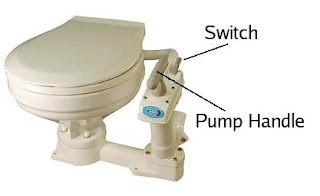 There are four toilets on the boat, one in each stateroom. You are responsible for your toilet. If you stop it up, you will have to un-stop it. I can assure you it is probably the least fun thing you will do this decade. Especially if it happens while we are at sea. I will not have much sympathy either. In fact, I will kind of smirk a bit, and stand in the doorway offering encouraging comments while you work on it. So don't fuck up your toilet!
There are four toilets on the boat, one in each stateroom. You are responsible for your toilet. If you stop it up, you will have to un-stop it. I can assure you it is probably the least fun thing you will do this decade. Especially if it happens while we are at sea. I will not have much sympathy either. In fact, I will kind of smirk a bit, and stand in the doorway offering encouraging comments while you work on it. So don't fuck up your toilet!How not to fuck up your toilet:
- Do not put anything into the toilet that doesn't come out of your body. This is limited to shit, piss, spit and vomit. You will notice that it doesn't include toilet paper, wet wipes, condoms, tampons, tissues, Q-tips, string, drugs, food, clothes, towels or small kittens.
- Put all used toilet paper overboard, or in a garbage can. I know that sounds disgusting to someone who might have never been anywhere outside the US, but this is the standard way of doing things anywhere else in the Americas.
- Flush thoroughly, at least thirty to fifty strokes of the pump handle.
- Use appropriate lubricants from time to time - more on that later.
- First, wash your hands. Believe it or not, your genitalia are probably not dirty (that's just something the prigs who started this country came over here believing), but your hands definitely are. Working on a boat will have brought your hands into contact with any number of awful things, including diesel fuel, motor oil, sea spray, dead fish and the captain, just to name a few. Touching yourself with those dirty hands is a bad idea.
- Now, look at the toilet. Just to the side of the bowl you should see a pump handle. Pumping this handle forces the waste contents out of the bowl and into either the holding tank or the ocean, depending on how some values are arranged, and also forces sea water into the bowl, depending on the position of a switch located just above the pump handle (see the picture above). Notice the position of the switch!
- Next pump the handle on the toilet a few times. Does water enter the bowl at the rim? If not, change the position of the switch, then pump some more. Water should swirl out of the rim of the bowl and into it. At the same time, any waste or sea water in the bowl should be pumped out of it.
- By pumping the handle with the switch in this "flush" position, you will fill the bowl with about one inch of sea water, and wet down the sides of the bowl in doing so. Getting the bowl wet means it will be less likely that anything will stick to it when you use the "captain's head". Don't make jokes, we've heard them already.
- Put down the toilet seat, sit down on the toilet seat and relieve yourself - even if you are male and need to pee. Do not stand up to pee, unless you are female. Any women willing to pee standing up has my utmost respect and is entitled to do whatever she wants. She is also likely to clean up if she misses. Men are not capable of peeing while standing up on a boat. Men believe they can, and when they piss all over the toilet, walls, floors, hose pipes and their feet, will ignore this fact because it interferes with their self esteem. Two days later it will stink to high heaven because some male ego is unable to admit they have non-laminar flow, lousy aim and are unwilling to deal with the consequences of it. So, dick holder, sit the fuck down, and do your business.
- Wipe your ass, if necessary, and dispose of the used tissue by either throwing it out the window (if we are out to sea) or by placing it in a garbage bag under the sink.
- The sink next to you has a removable faucet that can be used as a bidet. Even if we are rationing water, don't hesitate to use water for this purpose, unless we specifically say otherwise. This turned out to be a real delight for the women aboard - we've had several compliments about it. Makes you wonder about American plumbing, but we digress.
- Stand up, turn around and flush the head. To do so, pump the handle numerous times (between thirty and fifty) to flush out the waste and any additional sea water that is being flushed in. Stop only after the bowl has been completely rinsed, and you are sure the waste lines (all six to eight feet of them) have been completely flushed as well.
- Flip the switch to "dry" and pump the handle some more. In this position, the pump will continue to empty the bowl, but the toilet bowl rim will not flush new sea water. After five or ten pumps the bowl should be dry. Leave the toilet with the switch in this position.
- Wash your hands, and rinse down anywhere that needs it with the fresh water from the sink. Do not leave your head unclean, or a mighty angel will swoop down upon you and visit you with evil smells in the night.
NOTE: if you break the head, you will be very, very unhappy. I strongly encourage you, that before you create a diaster, to make sure you know exactly what you are doing, and ask for help, and do not try to fix things yourself unless you are damn sure you know what you are doing. I've seen piss, shit, vomit and any other number of bodily fluids before. You will not embarrass me if you ask for help. I assure you it will be very embarrassing if you have to repair a toilet while at sea.
Toilets are easy to use, but hard to fix. If the above instructions are confusing, don't sweat it, ask for help. Also, there are several valves that must be in the correct position to use the toilet. There is a sea water intake value, and a a waste exhaust value, both located in the area underneath the sink. Both these values should be in the "open" position (i.e. the valve handle in line with the hosepipe) for the system to work properly. There is also a waste direction value that directs the waste either to the sea or a holding tank, depending on the position of a value located deep in the back of the sink area. Normally these three valves will all be set up by myself, but you should be aware of their significance and understand how to open/close them properly.
Contraband, Drugs or Firearms On Board
Unless you can (and will) provide a doctors prescription for what you are taking, drugs (or any other contraband such as explosives or firearms) haves very serious consequences. Should the authorities find them on board, the owner (me, whether I knew about them or not) can go to jail, the boat can be impounded (never to be see again) and the loser who caused the problem will regret it for the rest of their short life. I will personally see to it that anyone bringing contraband aboard my vessel is convinced that they have made a serious mistake and begs for death - but I'm not bitter. Now, I'm sure some of you might think this is being a bit drastic, but sadly, the last trip I took involved someone showing up with some recreational material - they were very disappointed by my reaction. Aside from being unfuckingbelievably stupid (subjecting your host to imprisonment and loss of their home) it is also rude and impolite. I suggest you lookup Lazzareth Long's attitudes about this kind of behavior. Mine are more so.
Alcohol
Although I do enjoy the occasional drink, we are basically tee totalers and neither AnnMarie nor I will have any alcohol on board for ourselves. This means that anything alcoholic you wish to drink will your own responsibility. Bring whatever you like, and any mixers you might need as well. Use your own pineapple juice if you want to make a pina-colada, and keep it clearly labeled so there isn't any confusion. If you run out, don't assume we will want to donate to the cause.
You are an adult, and are welcome to drink as much as you desire, providing it doesn't compromise your abilities to safely stand watch. This means you start your watch sober. Other than that, have at.
Smoking
There is no smoking aboard. This isn't because I'm against it (I enjoy smoking cigarettes occasionally) but because of all the smells that permeate a boat (and contribute to sea sickness) cigarette smoke is probably the single most repugnant smell possible. To my knowledge, no one on this trip smokes (at least regularly) so this should be a non-issue. If you have addition issues here, then plan on bringing some nicotine gum or patches. Under perfect conditions, smoking may be possible if sitting on the sugar scope while we head towards windward and willing to provide everyone else on board with one as well. You must still ask permission first, and it isn't likely to be granted. Sorry, but I have to live on this boat long after you leave.
Good Times, Good Times...
Well, I've saved the best for last. At least, after reading through all this, I hope that all this talk of emergency procedures and restrictions on what you can or can't do didn't scare you off, and that you believe there might still be the possibility of having a good time. The reality of sailing long distances is that long periods of time are spend just chilling, listening to music, watching the dolphins play in the bow wake or sunbathing on the trampoline. There are few things more relaxing or enjoyable, especially when it isn't your boat!
So, please, take everything I've said with a grain of salt. This is a really special opportunity for all of us. I'd like it to be safe, but also fun, relaxing and enjoyable. I very much appreciate your coming along, and look forward to spending time with you on the ocean.
Post Script
If there was any part of this email that was confusing, poorly written, off putting or technically incorrect, please point it out to me. This document will eventually become the template for future sailing invites, so any input you can provide would be much appreciated.
Talk to you all soon.
Cheers,
Robb
--If you want to hear God laugh, tell him your plans.
PREVIOUS ENTRY | NEXT ENTRY

